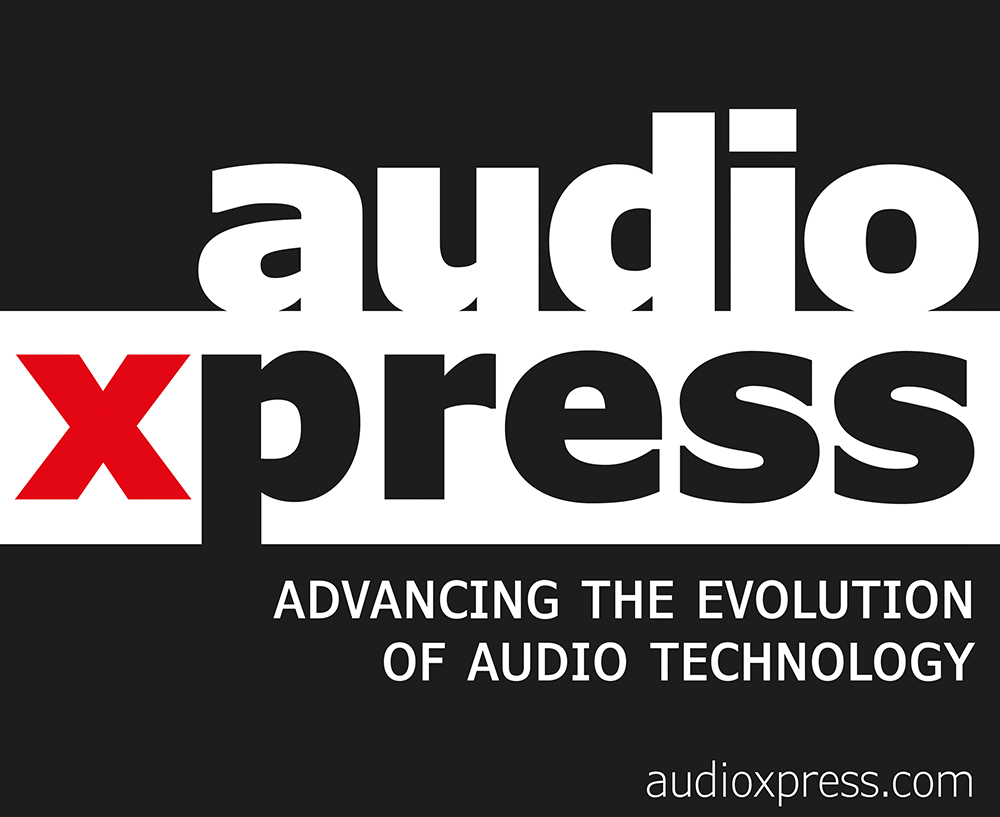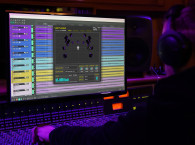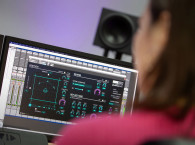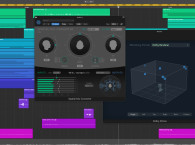
Applied Psychoacoustics Laboratory (APL) was founded in 2013 by Professor Hyunkook Lee, the Director of the Center for Audio and Psychoacoustic Engineering (CAPE)/APL at the University of Huddersfield, in the UK. APL now employs a multidisciplinary team of psychoacoustics researchers, digital audio signal processing engineers, sound engineers, and music producers and although it already sells its software, it remains grounded in its origins as an academic research project.
The ASPEN (APL Spatial Audio Engine) is the core technology developed by the research team, providing advanced virtual acoustic simulation (Figure 1).

Virtuoso v2, the most recent software update, now offers acoustic emulation, with customizable virtual listening rooms that mimic real environments (Photo 1). And Virtuoso v2 also delivers externalization and localization of sound, ensuring mix decisions translate well to loudspeakers, while simulating the experience of listening to loudspeakers in a perfectly tuned room (Figures 2-4). The software also currently provides EQ compensation for 100 headphone models, ensuring improved response accuracy (Figure 5).





Unsung Heroes
Every technology is dependent on reliable engineering tools to be successful. Products and audio productions that have an impact only happen when engineers feel comfortable using a new technology and controlling it with ease. APL’s Virtuoso v2 is one of these enabling tools, created to realize spatial audio production pipelines with just headphones as monitors.
Targeting immersive audio, in particular creating content for Dolby Atmos — one of the most important audio technology advancements of the later decades — is not an easy undertaking when it comes to equipping a reliable monitor environment. This is not just about putting speakers around the room and on the ceiling. The production and mastering process is way more lavish than with stereo mixing and requires monitoring the stereo downmix and binaural reproduction—as consumers will listen to Dolby Atmos content mainly using headphones and earbuds.
And during an audio production process, spatial monitoring will likely require additional steps and revisions — to be woven in just before the deadline — in which the full-blown mix room might not be available. This is where APL Virtuoso 2 comes into play. For this article I have used version 2.0, which was released in early October 2024.
What Is It?
APL’s Virtuoso v2 is a down-mixer and binauralizer. Auralization systems, which render spatial audio format channels into headphones, have been around for a long time. An early example being the Realiser audio processor from Smyth Research, and consumer products from Sony or beyerdynamic. Apart from being tied to hardware, which is expensive and not easily portable, early solutions were limited in format decoding capabilities and not exactly future proof.
The excellent beyerdynamic Headzone was an early example that was stuck at a maximum of six input channels, which is not enough to meet today’s requirements. Another early example was Waves’ Nx, which was a spatial audio renderer independent of metadata and delivery formats, designed as a headphone solution for audio professionals to virtualize a 3D acoustic space. Gradually, Nx evolved into room emulation using binaural modeling and offering 5.1, 7.1, and Ambisonics B-Format monitoring.
For immersive audio with its multitude of channels and metadata, a Mac/PC based software solution for signal processing is much more flexible and economical. While not practical for consumer applications, software running on a Mac/PC is perfect for professional production applications. Not surprisingly, most digital audio workstation solutions such as Avid Pro Tools or Apple Logic have integrated binaural rendering engines, including the official Dolby Renderer for mixing in Atmos.
As a plug-in and standalone auralization tool, APL’s Virtuoso v2 can take in multichannel audio sources and process them in such a way, that the playback over headphones translates the specific location of each channel into the headphones. And it supports a remarkable number of spatial formats including Dolby Atmos, Auro-3D, MPEG-H, and Ambisonics.
When listening on headphones, the impression of spatial playback, speaker-like sound, and the sensation of audio coming from more directions than just plain left and right is achieved. To make this possible, APL’s Virtuoso ingests all the incoming audio from a long list of potential input formats. Then, each channel is convoluted with an impulse response of a well-known speaker. A virtual position is created through the angle-dependent application of a HRTF. The specific applied angle can be fine adjusted manually or dynamically by a head-tracking device. To add the characteristics of a real listening room, an artificial reverb is added. In the last processing step, the output signal is equalized, to level out the discrepancies of the used headphones.
How Well Does It Work in Practice?
The installation is quick and easy. Besides the plug-in formats VST3, AU and AAX, a standalone version with real-time audio input and ADM file playback (Dolby’s container format for distribution) is available for installation.
To allow for proper testing, I have routed audio on my Mac into a virtual audio device with 16 channels. In the Audio MIDI Setup app, this virtual device was declared as a 7.1.4 sink, which macOS then in return recognized as an allowable LPCM output device. In the DAW Reaper the virtual audio device’s signals were then picked up and routed into the Virtuoso v2 plug-in. This allowed me to listen to multichannel output from Netflix, Apple’s Music and Apple TV app in real time without the need to bounce or create files (Figure 6). This went well and allowed me to do some extensive listening tests.

The first setup phase was quick. After two hours I was already clocked in on my preferred settings in Virtuoso. The plug-in accepts a head-tracking device input. Since I had by chance Ben Supper’s “Head Tracker 1,” at hand (see Resources), I have connected its driver Bridgehead (great pun by the way) to Virtuoso via OSC, a TCP-based control signal protocol with high resolution. The configuration was smooth and went well. The driver has a Virtuoso preset included and it worked instantly (Figure 7).

During listening I found the head tracking to be helpful to “arrive” in and understand the virtual room with its imaginary speakers. From time to time, I switched the head tracking off. I think, especially for listeners who do not have a lot of experience with conscious spatial perception, the head tracking is helpful, but it is by no means a must.
To assess the output quality of the binauralizer, I was cross-referencing with my AirPods Pro 2 and a 7.1.4 audio system with two subwoofers that I have in the living room. The rendered audio from Virtuoso sounds better than the binauralizer from the AirPods. The sound is livelier, and channel separation is clearer. The out-of-head imaging was only partially achieved for me during testing. Since I know that this a tricky one for me and rarely achieved, I am not disappointed. It could be very different for you!
The head tracking made the whole effect slightly more convincing for my brain and I gained a good sense of space and position of sources. In the main window of the plug-in, the virtual listening position is mirrored through a grey head that gives instant feedback about the rendered position. The display of the head is rather small, and it takes a second to grasp the virtual position. Other head tracking solutions such as Waves’ Nx have a better display for that aspect.
In a test mixing session, I used Virtuoso on one of the mix busses and routed the output to a headphone output (Photo 2). That all went smoothly and well. I am a little doubtful if I could really make mix decisions on that system, but it is probably only a matter of time before one is acquainted with the ins and outs of a system like that.

Fly in the Ointment
During work with the plug-in, I was desperately missing a safety limiter. Down-mixes can easily crash a mix bus and that happened to me several times, especially when I used the headphone correction (HPC EQ, Figure 8), which can add several decibels in some bands.

The integrated room simulation was disappointing for me. The rooms sounded unfortunately dull and unconvincing to me. The only room simulation preset I liked was “dubbing stage.” There was a lovely slap-back sound that instantly felt familiar to me and reminded me of the small cinemas I visited when I was a student. It put a smile on my face.
Use caution with the parameter “distance.” When I adjusted the distance while audio was being processed, nasty overshoots and a good amount of crackling was audible. I hope this will be rectified in future versions. Since this parameter is not so often manipulated, this can be rated as a minor issue.
A very fun use case for Virtuoso v2 was to investigate into how current Atmos mixes are structured. The solo/mute function for single channels and speakers allows for a deep look into the aesthetics and approaches currently used in Atmos music mixing — it was almost like having an original multitrack of a recording at hand. The applied mix aesthetics are wild! As these aesthetics are just being established, it is so much fun to see the artists’ and engineers’ intentions and dissect in detail what is going on in the mix. These are exciting times, only comparable to the introduction of stereo and quad LPs and I am happy to be able to experience it firsthand.
Conclusion
APL’s Virtuoso v2 is an important instrument in the immersive mix engineer’s toolbox. For technically interested listeners, I see here a great piece of software, that allows users to be actively involved in the listening process, if you fancy immersion and headphones.
The functions and user experience are well-thought-out, although there are some minor issues in the user experience, that I am sure will be rectified soon. The GUI simplifies a complex process in an intuitive way. The signal processing pipeline includes everything needed for a proper auralization in one package.
During testing I liked the output quality of the Virtuoso v2 plug-in. I never fully felt the illusion that the headphones disappeared, and sources were located out of my head. But I do not think that this is necessarily the point. It is more the functionality that makes this plug-in compelling. It is best to try it out for yourself and see if it works for you. Virtuoso v2 allows us to have a reliable and portable “room” always with you during a production. It is a great quality control, experimentation, referencing, learning and listening tool. It is perfect for mix session preparation or revisioning.
Resources
Applied Psychoacoustics Laboratory (APL), https://apl-hud.com/product/virtuoso-plugins
Ben Supper Head Tracker, https://supperware.co.uk/headtracker-overview
Smyth Research Realiser Audio Processor, https://smyth-research.com
Waves Nx Virtual Mix Room over Headphones, www.waves.com/plugins/nx
This article was originally published in audioXpress, January 2025






